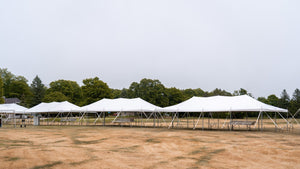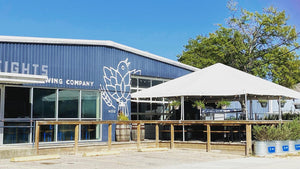
When you’re planning an outdoor event, weather is always top of mind. A tent can provide much-needed shelter from the sun and unexpected rain—but what about wind?
If you've ever wondered how much wind a tent can really handle, you’re not alone. In this guide, we’ll break down wind safety recommendations and explore which tent types are best suited for handling blustery conditions, so you can plan with confidence.
Why Wind Ratings Matter

If you’re hosting an outdoor event, knowing how much wind your tent can handle isn’t just helpful — it’s critical. For large public events like school functions, festivals, or community gatherings, safety should always come first.
It’s important to know the wind speed at which you should evacuate the tent to keep your guests safe. Having an evacuation plan makes it easy to act fast and get everyone indoors if the weather takes a turn. Keep in mind that most event tents are non-engineered and temporary, so they usually don’t include a certified wind rating.
In certain areas, you may need to provide your tent’s wind rating to secure a permit. The location, type of event, and how long your tent will be set up all factor into whether wind documentation is required.
How Wind Is Measured & Why It Matter for Your Tent

Wind is typically measured in miles per hour (mph), but it’s not just about how fast the wind is blowing — it’s about what that wind can carry. As wind speeds increase, so does the risk of flying debris, falling branches, or other objects that could damage your tent or create safety hazards.
One helpful tool for understanding wind impact is the Beaufort Scale, which describes what different wind speeds feel like in the real world. For example, between 25 and 31 mph, large tree branches sway heavily and can snap off — easily causing damage to tents and outdoor setups.
If weather forecasts predict sustained winds above 36 mph or gusts lasting more than six seconds, the tent should be evacuated immediately and guests directed indoors. High winds can loosen ratchet straps, pull stakes from the ground, or cause poles to shift or sink, which can compromise the entire structure.
That’s why it is critical to monitor both forecasted winds and potential gusts leading up to and during your event. Staying alert allows you to take action before conditions become unsafe.
Need a High-Quality Outdoor Tent? Call Us!
Enhance your outdoor events with a heavy-duty tent and the right accessories. Call us today and let our experienced team guide you to find the perfect shelter made with commercial-grade materials you can count on.
Discover the many options we offer by calling us: 920-431-0938
General Wind Resistance by Tent Type
Most tents used for events are considered non-engineered temporary structures and do not have a certified wind rating. However, performance can vary significantly depending on the tent style. Here is a quick breakdown to help you select the right option for your event:
Pop-Up Canopy Tent

Wind resistance for pop-up tents is generally very low. These lightweight tents are designed for short-term, daily use and are often set up without proper tie-downs. Without anchors or stakes, they are not recommended for use on a windy day. Pop-up tents sold at big box stores or online are typically not rated for long-term or commercial use.
If you need a more durable option, check out the Shademaker Pop-Up Tent. It’s built with commercial-grade blockout vinyl and reinforced with tie-down points at every corner for improved stability.
Atrium Frame Tents

Like most west-coast style frame tents, these are non-engineered temporary structures with no official wind rating. However, they are wind resistant! For safety, we recommend evacuating the tent at sustained wind speeds of 36 mph.
One standout feature of our larger frame tents is their double tube rafter poles, which provide up to 300% greater strength compared to single tubes. This added reinforcement helps improve overall durability and the tent’s wind resistance where it’s needed most, giving you extra peace of mind.
Frame tents can be staked into the ground or ballasted with weights. If staking is not possible, make sure you use the proper amount and type of ballast. Standard 55-gallon drums can slide or tip under wind pressure. Engineered ballasting systems provide better stability and safety for frame tents.
Capitol Pole Tents

Pole tents share the same wind safety recommendation — evacuate at sustained winds of 36 mph. Pole tents rely heavily on proper tensioning and securely driven stakes, as they do not have a rigid frame. It is important to regularly check stakes and ratchet straps during moderate wind to ensure everything remains secure.
Ameritrac Keder Tents

Keder Tents also follow the same 36 mph evacuation guideline in case of tent failure. However, they tend to perform best in windy weather compared to other non-engineered tents. The keder track system keeps the fabric tight, reducing flapping and stress on the tent. If winds exceed safe limits, the fabric can easily be slid out of the track without disassembling the frame — helping to protect your tent investment. Keder tents are one of the best choices for long-term, non-engineered applications.
Structure Tents
Structure tents are a different category altogether. Structure tents typically come engineered to withstand high winds of 75+ mph and are designed for semi-permanent or long-term use in high-wind environments. These tents are ideal for critical installations or challenging locations, but they do come with a higher price point compared to temporary tent structures.
What Impacts a Tent’s Wind Performance?

Several factors affect how well a tent performs in windy conditions. It’s not just about the tent’s design. Proper setup, maintenance, and materials all play a role in keeping your tent stable and secure. Here are some key things to keep in mind:
-
Tent Quality: High-quality materials and strong, reliable tie-down points are essential. A well-made tent will always perform better than a cheaper alternative.
-
Proper Anchoring: Whether you’re using stakes or a tent ballasting system, make sure your tent is securely anchored for the site conditions.
-
Tent Size: Smaller tents naturally tend to handle wind better than larger structures due to lower surface area.
-
Ground Type: Soft or wet soil can cause stakes to pull out more easily. Always check the ground conditions before setup.
-
Safe Installation: Whether you are setting up the tent yourself or hiring professionals, proper installation is critical for safety.
-
Ongoing Maintenance: Regular maintenance helps ensure your tent stays in good condition event after event, so it is ready to perform even in bad weather.
Tips to Maximize Wind Resistance

If you want your tent to perform well in windy conditions, start by investing in quality materials and following proper setup practices. Not all tents are created equal — stronger materials, better hardware, and correct anchoring make all the difference. Here are key features and tips to help your tent stand up to the elements:
-
1000 denier, 16 oz blockout vinyl — the strongest tent fabric available
-
ISO-certified suppliers — for consistent fabric quality with every order
-
UV protection coating — prevents cracking and fading, lasts 3 times longer than imported materials
-
Reliable frame construction — with minimum 2" diameter poles
-
Double tube rafter poles on large frame tents — for added strength and greater wind resistance
-
Reliable tie downs — use 2" ratchet straps and 42" double-headed steel stakes for secure anchoring
Always follow the manufacturer’s guidelines for proper staking or ballasting based on your tent type and site conditions. Perform regular maintenance checks on stakes, guy lines, and hardware during setup and throughout your event, tightening any loose components and replacing worn items as needed. After each use, inspect your tent fabric and structure for any signs of damage or wear. If you have any doubts about the integrity of your tent or anchoring system, consult your tent manufacturer or a professional engineer.
If you are using sidewalls, keep in mind that while they can help block wind and improve comfort for your guests, they also increase the tent’s surface area and can add more pressure to the structure in high winds. If strong winds are in the forecast, consider removing the sidewalls to allow wind to pass through and reduce strain on the tent.
Looking for a Durable Tent? Contact Our Team!
Looking to protect your outdoor celebration with a reliable tent and the right equipment? Your search ends here! Call us today and let our team of experts guide you to find the perfect canopy and accessories that will transform your special day into an unforgettable celebration.
Discover the many options we offer by calling us: 920-431-0938
Plan With Confidence & Choose a Tent That Stands Up to the Wind

A gentle breeze is always welcome at an outdoor event, but stronger winds can quickly turn into a safety risk. How much wind your tent can handle depends on the style, tent material quality, setup, and the environment where it is installed.
If you are a venue, rental company, or someone who regularly hosts outdoor events, investing in a tent that is built to perform in the wind is one of the smartest moves you can make. It allows you to focus on what really matters, creating a successful and stress-free event without worrying about the forecast.
At American Tent, safety is always our number one priority. If we believe wind speeds are unsafe for your tent setup, we will tell you. We are here to help you choose the best tent for your location and conditions, and we will provide expert recommendations to help you host with confidence. We also offer post-sale phone support and guided installation options if you want a little extra peace of mind.
Ready to find the perfect tent for your next event? Explore our Tent Selection Guide, event planning articles, and setup tutorials. Or get in touch with us at 920-431-0938. We are here to help every step of the way.








